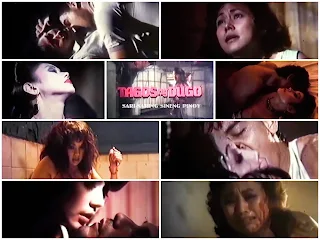What Vilma Santos achieves in Maryo J. de los Reyes' Tagos ng Dugo (VH Films, 1987) isn't a performance but an embodiment. With courage, art and charity, she empathizes with Josepina Ramos Regala, a damaged woman who simply asks that we witness a woman's final desperate attempt to be a better person than her fate intended. The performance is so focused and intense that it becomes a fact of life. Observe the way Santos controls her eyes in the film; there is not a flicker of inattention, as she urgently communicates what she is feeling and thinking. There's the uncanny sensation that Santos has forgotten the camera and the screenplay and is directly channeling her ideas about Pina. She has made herself the instrument of this character. Her transformation into a street prostitute, where she strides into the shadows before stepping forward to talk with Cesar Garcia (Miguel Rodriguez), a handsome young man who has found her in a strip mall after dark. I was simply watching one of the most real people I had ever seen on the screen. Pina's initial kill is justifiable. Having been raped as a child, she uses the knife in self-defense. Pina’s victims become progressively more innocent, with one simply being in the wrong place at the wrong time. With a dying conscience, she dispatches Edwin (Michael de Mesa) and seals her fate. De Los Reyes presents the killings in a straightforward manner. Although we understand Pina's reasoning, we neither sympathize nor empathize with her.
Tagos ng Dugo asks for a measure of comprehension, not identification. And it demands that we consider what role (if any) society may have played. That approach, more than any other, defuses charges of exploitation and moral indifference, making this a compelling, thought-provoking and unsettling drama. Movies like this are perfect when they get made, before they're grounded down by analysis. There is a certain tone in the voices of some critics that I detest. That superior way of explaining technique in order to destroy it. They imply that because they can explain how Santos did it, she didn't do it. But she does it. Pina's body language is frightening and fascinating. She doesn't know how to occupy her body. Watch Santos as she goes through a repertory of little arm straightenings, body adjustments and head tosses and hair touchings, as she nervously tries to shake out her nervousness and look at ease. And note that there is only one moment in the movie where she seems relaxed and at peace with herself; you will know the scene, and it will explain itself. Francis Arnaiz finds the correct note for Andy Mercado. Some critics have mistaken it for bad acting, when in fact it is sublime acting in its portrayal of a bad actor. We are told to hate the sin but not the sinner and as I watched Tagos ng Dugo, I began to see it as an exercise in the theological virtue of charity. It refuses to objectify Pina insisting instead on seeing her as someone worthy of our attention. She has been so cruelly twisted by life and is unequipped for this struggle. She is impulsive, reckless, angry and violent and she devastates her victims and herself. There are no excuses for what she does, but there are reasons and the purpose of the movie is to make them visible. If life had given her anything at all to work with, we would feel no sympathy. But life has beaten her beyond redemption.
Director of Photography: Ely Cruz
Production Designed By: Cesar Hernando & Lea Locsin
Film Editing: Jess Navarro
Musical Director: Jaime Fabregas
Sound Engineer: Joe Climaco
Screenplay: Jake Tordesillas
Directed By: Maryo J. de los Reyes






